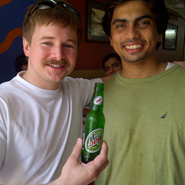 By Jamie Thompson
By Jamie Thompson
Visiting the bustling Indian metropolis of Mumbai, also known as Bombay, is like stepping into an unpredictable time warp. Sometimes life feels like it is happening in slow motion. At other moments, commerce feels like a higher power is stepping on the gas of growth with a lead foot.
During a recent trip to India to explore the shopper marketing and mobile landscape, I was initially shocked by how the corporate world responds to the clock.
Unlike the fairly rigid appointment norms in Manhattan and Boston, executives in Mumbai loosely commit to meeting times, though they do honor specific days.
Time’s now
Not sticking to a schedule is not about disrespecting people’s time.
My hunch is that this laissez-faire attitude stems from the futility of planning around the chaotic transportation system. An otherwise 15-minute cab ride can easily take two hours, depending on the congestion of rickshaws, motorbikes, cars, cows and millions of pedestrians sharing the streets.
Yet, the pace of commerce shifts to warp speed the second you pop your head in one of the countless small convenience stores and roadside food stands dotting the landscape.
Shop owners know that if they do not give you what you want and make you happy quickly, their competition next door will eagerly fill the void.
This is a hyper-competitive and efficient market. Small stores and a growing number of big-box retailers are well staffed and ready to serve, although the latter are few and far between at the moment.
Rising above this contradictory mix of fast and slow business transactions is the insatiable Indian appetite for ubiquitous mobile communication, information and entertainment.
According to the Telecom Regulatory Authority of India (TRAI), the country now boasts more than 850 million mobile subscribers – almost double the combined population of the United States, Canada and Mexico – and keeps adding more than 10 million new subscribers to the networks every month.
Informa, a British telecommunications forecasting firm, projects that India will become the top mobile market on the planet by the end of 2013 with 1.159 billion subscribers.
Google also claims that India is now the third-largest user of the Internet in the world (100 million) behind China (600 million) and the U.S. (300 million).
Smartphones are soon expected to surpass personal computers as the primary Internet access point for Indians. I saw evidence of this in the streets.
Even in the slums, every Indian seems to have a mobile phone constantly in hand. Many even have dual-SIM phones that can handle accounts from different carriers on the same handset.
Users are notoriously fickle, freely switching back and forth between service providers depending on who is offering the better plan of the moment. Long-term contracts are rare. Prepaid voice and data rule the airwaves.
More than a dozen wireless carriers – led by Airtel, Reliance, Vodafone and Idea – compete for this ultimate business of volume.
Tapping opportunity
Tired of sitting in the world’s worst traffic, Indians are clamoring for immediate access to information and mobile marketers have unprecedented opportunities to deliver. Some observations on how to make an impact there:
1. Embrace fast-moving consumer goods (FMCGs) – Indian consumers are motivated by freshness, buying only what they need in the moment and making frequent return visits to the store as necessary.
There is no concept of buying a 30-gallon “economy” jar of peanut butter or stocking up on enough soda to supply an army. This buying pattern makes food packaging an ideal medium for interactive mobile campaigns and sets the stage for ongoing engagement and social gaming.
2. Do not rely on applications – India’s deeply fragmented carrier and handset market means there are no universal apps guaranteed to work on every device.
The best way to ensure wide participation in a campaign is to interact through picture messaging, email, the mobile browser or an up-leveling of SMS marketing.
3. Rethink how you distribute rewards – Companies that offer physical rewards or offers through direct mail fulfillment discover that delivery costs can easily outstrip the value of the prizes.
Digital coupons or credits are much easier to send electronically and provide instant gratification.
4. Out-of-home advertising still rules India -- Out-of-home signs are everywhere. Yes, there are huge billboards like any city, but it is the signs hanging above the small shops that are most intriguing. Big brands pay shopkeepers to display the signs there.
Store owners are in a powerful position to push certain brands over others. Brands must mass distribute these signs and come up with incentives for the best shelf placement and sales rewards. Mobile is an opportunity to create a bridge from traditional marketing to the constantly connected shopper.
MOBILE GAMES AND rewards programs can help FMCG brands compete against traditional homemade food and drinks.
For example, freshly pressed juice is available on nearly every street corner, providing tough territory for pre-packaged sodas and sweetened beverages.
Customers looking for a sugar buzz might make an impulsive purchase of something new if given a compelling reason to be tempted. But it might be worth figuring out how to incentivize the roadside juice salesman, too.
Mumbai has a spirit of adventure and entrepreneurship like nothing I have ever seen.
A global juggernaut in every way, this place has more entrepreneurs and small business owners than Boston, New York and Silicon Valley combined.
Indian shopkeepers may not all have dreams of IPOs and billions in revenue, but they do collectively control the fate of some of the world’s biggest brands.
More commentary on mobile in Bombay is available at http://blog.pongr.com/mumbai
Jamie Thompson is cofounder/CEO of Pongr, a Boston-based mobile social gaming and image technology provider. Reach him at [email protected].





{"ct":"d2wIj3jPkEI8i\/EYlHo21pl110g+wEotsZDBZAI+IZsQ1qxpQeYajozlfmg+y2P8NtQjyPFyD\/FVdzk8qWGkjVaw3e+WclKLYt6p2r7onVogJe1vSusfMIw\/55N2kdLkF\/XBuqVtOC45npa1CgQFAbp9DdJwTSdphc2aLVElji+psIpMsX+eEJ1rO9M+nBo7T\/z7TIwROywcWUgzQxhcgFebDjHs9CGKQKzSz2rPd6IN6aTKO\/nubZqK7rhT9\/qcKjTJl5ZPJDF6BLT4bbII1iBbsfnvukJ0eQ5pThxY28nmyPvXGWrFuJUgoR2q\/MIicDwRNZNX9D1SOEqi1uskT0Z4L0FF9q4Zr8qVxr6qL62kli882XgY\/A\/YvSxdwpGwmyIvZFWXLn\/NhNbayibYD0F\/xQPptyRzFWr3w+NzEf87BTfSPbOZtEd39xJTns18PihmI33chEtrgeLvazJNLOkvxJ5UC9ZP5LZw7H0WZz903jHBWuKDE5T5zaRxMDxEfS+2jMdiYh2fFsIYpkb9pyLzg8KWM54J6gp0umsLp4yhs5F1uor6RfdAZJtfI\/GtzmZ5fECKYIUCoGFwa0T+WnqpEHJdQmASmxAkppiZzFi\/\/C\/\/ch7FtvtstCenWr1P7Q34D9DZHO5dVXHB1v4HktdT7rKEQJOT1Z\/UQb08KcPOzXOjom7oJ\/gVk74awYzOdASXglrhsfbuyYpMg68WXRDfdkt9vsUIpXnUiRiJDCmvmlG8\/nq5bvGA8tOFLk3o5GcotBQRmIa0TyKnYKuZclUu4VyTVAySF5dwHyOPvP0rXRa52UVXg0PEsHUJAWf9rBtEojvhSaxBdB8Q1PJth2qgqcKCF2rloEGtry2AeWsOt\/k3D41T9Zd8oJY5aEOlKtthHQrsJ194KcC1Z6aCvGhFER2POismDDyVQNCCk2ryUoXSN3fniWP9nQMxjFxGuJnGYOaQE2HFvzdhVLAOPCFbCQMG0TQC9EusuQr7HhqZ62xgW8Zw3xEbaGk46Jvfv5zaVecy9i5RlbKw2UnMwC9lDdRQhoZEpHeyNqrBnH+go8iuniNMxuIC9fLZ9fbsUrpoIZuiaY5SvdepmV1nUnvn4BBDaAAvEKqcaYj76U9VHQgk6awp1nVm6ep\/XH\/mUv8ZWTp932c1Rpax3B9ZljBZTOW22DjFMRaG9HVPk\/8+HgQxWUUb4KOt2b6sSTpleLlZrzDqKBmDlh6JZWvx4TvQyt3lKDK7jBVF6z45DOBnW4\/b8D7+UqWVCsfqlwu1tmhVf8fhJkdF+SSgkXoMw\/tyeqUbTRQE7p09bPhz0qSxjkC3fg5yQWoEgbfa4LyY2e3MSuuFcsoNC7vVtwEJAN6bmvuc8zqvqksC0PX3Kt+IXDNHYeFo9Um1PXQPQCWHHHxPP4Eg\/N8J5IRfOG1jBaxP4EASHjmEpsfFah4U3w1b2bVq9tQc8\/OMgO2gCoLoY\/w3uvrKiaaTD694czKFRxWiG05+L3S42CoDrGGQBMUJKTEE\/S\/jmpRswB6ysTzojWjwAihmrjRKLqWHI4VXst\/sUIWSAyN5D4kuIX9y+4fELgR2APKQY9Z2KZ3OqOdBe1p7Ey78LP0nUeNSALbVM8dogoN75feekfh89Hgl85zcWYcymvuphcbNPuxemaPBJrBKh58DwfcJwG98ZoQGEojst6DZFhxxMCV7q+H8N78\/O3q1TysUf7D+ZRvbjYxGghZPJrYEchowBL7VqkEEqYwVG\/NUZzQmP5uqA0uAeEDOUhY6dbPggQRHW7CFHLUKDNqZ1I7rq8BSECSKvjKIb\/5+m4ElR70bMRQrlqLma7VuybQapR4Jv\/DM+o8TeamqcOco77tc6eH7VFx0NobcdwB\/Xe7cXnbyaCsz8III5rZFOlmFDT1PO7TAdWN0QsJl1AiPh\/RGLqqpvkrZ9To2OYBZA830hW1mLRp6UG8q\/mvPGRzuuY5TueVMzOSPnccI4OuQuRjKbp+mLBNS4gTNUd20s+R\/uBblNgQLBhbHg9buiKjjAWi\/oAMlSQ5QUnva0KF1gY21eQc1y7nAAr48hVGA33HNqej1YBeY6edv02hVYHGxeksxQOjAT7iIG8hojTjwywNHN\/o117FjSl2mzxnB8qAfoFY68C4dPNzVYs2fR8mGLCzPH6ihSXKVP\/X0vpVJFT89KIXnCWSOoWqK8ErQjvHfhHoq+cuQBq4Wt0TnKt4eOCWyDY+mb7R6CXojpQijlOdLLtCYLo\/cwYwIQD4r4N2rZRJ0In5W6b+GHOC7ple3rdgnFVhdw0l0PU3xpqYkA5OFzUoClSA0rqJxdLRTiwLDUeW9Sz3bB3wNBBpVwSj+BkaM9N9PN5YFZrwTcV\/VpCjD809LqLzjWnGQ8LMXCYOUJZXZPoUsbUoo28nUFlwDSOM5TlsBt\/yCjP2eCOUKBsCmdFaVy+x4Pd7EoK566oSg3BTQy4l\/oHbxhIQRbCX9srLgmbnOCQNg\/jNDGR4z2q8xNYbSmeSRkCG\/UFhOewFWREKoEBMW5ISbiVuntw5XpqPBkI9Kr1DTz0Y2MafieFDuTS2sShvLBf+qOMbN4etLyoHwUcyQdTq4399M9LsOGmbYF5I22TyBj3wdqE5JrZePp5tLefCfG5pBGJPdwva\/nRyAH2h\/DAfkokwvY\/rsjOFAc+q114m7pO3N2PfOuntgHRDR+jepetpRSScwO6+s5io3sUWvA67pNvcfZLa\/fTHaodKM97ECpAfGinPvZDcmNvcEFF+XYzb+zCjKaK+DQBI4Muwv\/m\/qcYvJuhJC2P0u2\/Sh8\/vGXi9zdWxV2SGpk4KK5Xe8HSwZLjW9dseHtbgiktCqhhrOgg\/tel39iekL2His+kC7cXYBCKzAlbxpEwaLMTfL3+Z9gZ8XlSUe7nDM\/bDSHtNKA0ncMDo1COZ+x381qtcayScUc+jB71VcUlv9Dy0FXrjdiBP2R\/rrh5qb6telyZrygokHLlNwxPmZtJhdAlXgarC53ClXkJhnDLOyGMe7L6DSQufWpudv2Tr2CSAuwQZ4DOcdkja+vp0HYsuzJJ\/5dIefMTePE\/Gn+PG3G+bN7bryJKbvT87L\/lC2N8djeyQUszOHLyMamAuQCKNrEUS1prhQU2+wLKk9Yg6aNS2KngnndLnkZjHYrh05jnj0ZbG2wZp6rl6OsDc3O9fQv5MlAby0huYO1KR6HIg5uEKbSRN+BhmpgesfCDrvIXvrJ1TMufeUmEobdZbKoA13OD0KBTtweg7Y1aeAy78REdZeGyoSlui2zVvduRqYIrJSVmLIGeIWixz4nIR7FtK4JnHflZk8GivwVJ+Bm6NJnb\/GLXi33d03W5ec9kkACCrdgodKN4mZ7vhvg9QZGlIJfdP39a3Ji45IoMJu8blDt\/TdXhYc9W6UdkBRhjP5814skJC9QdKlt9SepkB\/MbwCP+fhgBspjtMOD+Uej5nT52ukMihx2mkcQlVLa1tEZFoagLyXAuGdhPnZUK\/lR5TpReXruLyRlmAaEj0pKDAFjPqLiSPd106ynpWxv8988PIPAixHm\/Wlp4qVUY4sWh7W1Hn6pPBTF5f3Ovw7oxksgyiZTGbo80D3qV6SgZzDDUD5risQgDPQj74LAaC4F2Z5CmhkMSJ+JFQnFq258PqHpRCeA69fSWcyVL3J5VhiBB+sRCGxVzOo4MoMdQkFdALFRmzFqp7pjLUgkHIzOmIzxBB7inqu5YMXjNJJkngmZuD1T+7dazAES1wzpR0PuF37rT4HtoL0xltJr77\/jTa4BvQvQxJCz2fQbHK8xsEDNPn1+SpdTR8V30yB07KuH9jRA5PWCqqhUYl\/wgk6zC0fymmtR5+S9WbpR8ZFZTbIOsJqyzmRQ0kRCWO+LS0xh2CmP\/kkoSoy2XOVb89ShD9TSNRkQwdzDji8549AsIx+fzetWw2C+h91z33MCF5io3YLRHM5T0f4UYw71m02GFOR4HJNQSeVgntEbVxcygcJLqtJGWCq1ob4I424moIWGkAQJz50PESUJnL5j6froMo1\/FVAHDuLDfre0c1qXrFju+vPuMBlNrFfKnKG+Km6LNffUwA6hJg3Ov4NOzd6bRn4q\/dnKj3o49DdPFL28RyziHL4NVWPIGGgE\/7E4VGdnnSWbxCZik+cHzZ9SMxW02qjP1Ui1FuB0QqvcHGcZLU248HGwx8koRHLCFMTQ3QKxAHGFXwBa9oujbRqgFOPrxk5jw6og\/Z1zAHidkTCU3O17sAR77Is0q0DnaN0As6qsEpfN4SMWFZGSjmo2D9OuTTHBy5OaQnWdqpQ4zuGff5O9sD30ioH6\/u+iYrzY2GIesRIdzuB9oPIqYsvdJwAicRUyOQIbKrOr7TSJk\/35XIkshjCA\/uTaxOb5lW7fk1Of3W0g85yqJj0VlmnEycv2glTHUzcnI0NK1L++0y3HCmTCFF8rjklVGkeWMl7ISCQq42al9eOn7opCgaT8cjFd+dBOzxx2YGV+nS11uN5CefZE5pl6l7dANI+xlLZntfg33Y\/wSBKlC9HqZUXd\/1zfSZRrU9E1K5W5SlElHAKQ\/\/T\/4pbtEXreUesXZHtV93j8C36QYfMXX5+v7KvnTaksvLATlB54pc90f8HThUg2\/cWA5m1qDh4OFVOqkcjx4Y\/\/UBDURYrgCsBYPUoZUAoOe+8agqRnmcUGcugDlJ7GYg6Fgg5HEbNeZDjhFNwtyw6A2kANbtdYyyGG5QYDGEVMHIhYQDCsmGlSFgIDvqvukt5+ytGYxD9eoP0ERc2S5BUOc3VRnFra1OmIe8DrrocERfdD6JQs5tXbOcLKFo54HF9nQrHwen4aUBdWNEzrJLlrcgSMh3Yj0VmF3NobNWD5jCAFurysukKsL\/gzK6JuM\/LQK6WLeGO4PneOieLSBkabNLnvJK+b88IAgH4k28alAb3SFbxvSz+UsYJ1BNF\/O93mlEGnDRRdce4uGUisxfcwUPDX1a9b+xcQy4OYuWal0yc8ZMzC6j5EjPCjt8Ol97D4UKFogQmUIuAo8F6eybiyfFWPC\/xCPgDf42ljD6luZjW93ZKhS5wj5ZN6KLQA9nVElQpyOspncu7GmyXUs2\/RixWKUjugFirPuR+Vu6k7x1DfmOPFl9uzomZU5z9ynkxz1f4clk+Z555NfKOzuXyUwgDrnV0V9DgWhV9iBF0lJTfrgF\/qCyxiMacpqOuuOANRYoaWu9Kf+E+BYhLCF2aHbHyMn19ymqQjUgxYfFZUqPY7igenA8uviJh3\/Ymr8cRf995Jge76AAq9fXTxXBksjK3C\/KdcILZOTd\/R6afkaVzla9Cm55hhNqwgGQOMWxY3eNTr7CzWSgEyhnQHcfQ65bbD5qgRrMx8n+TiqGdfFx59S6Hto7w86J7xjkaPOVyryDIuD295iTuuWFdhGRpP6s9mQkbbfkG5l3E0jUu8kxfJNgaL3+MMm1UkKrQ29+Ul2QmwQjPnG6XC7Yy\/9YnwQmYtTvhXbH0EtBnEUXn3XWCwXGQzI+OcWGhrLUrLH2Twe3XkIUq+uenSKQyIx8KL8bYIjKSZh5CW\/gCKUCYZhLz\/X3n1R8JzyCJ0nhnlQtizcYABDJ+wqa3GQ3PMT2got83EQ3R6XG3\/NwAp8nXXNtG52DIGz29ac5LKOBJUKeRuK15YXwZ+28yhfpuFzb6a5Bg9TOJhVy3zlYnHuvW24\/rQZo1TyU\/jBX4SoItlDXiGf+ila68o26mLyGowlwtzASu5Be3C0vxCV08xB4TZjhr7w0M+451d47mKT8uh4kngZBUpxhLm56DCmHqyGZ8YlvJfIgg5CLbRnt2xuSJwORj1KOhDbrXKDSFiVWxq6Y02fIjo9vJ0IpswGwi+j6d8ityr9sCToCB0PGzFIfgnvWpaLy+Uag1u56RvPn2nkulNM99XxE9M\/Bonm51lIqAUC1dcYZacRz2ur+CJHiWUcMb0sknn425HigtjHIJoTVueOgr0kMYeXvANWzVMqGWpnzGAwAQVlcqJb\/SoFa92SwO6YimwXA1fQgH7fwOTS4DZ0w7MhNXLUuwBl3HPJ341u0+tx1xHSdDPyClWEYfNULDrOYocsWcUR37g1oNb3SGFKL86OWQjfrkr5DxYRA2OeGiketGN5OuSbZxfCKro9egXyiMMAvJyD4J9JcKvFsRtFW\/UNeDuwOuLTOywis2lKVw6eVqGuNoskUlO\/2XoUEMJFDsOCcM9Uky42G1WUSNbDG1RBwq4BuKsORs9S9gmJ6q5aPPV1pD5yyKBmUttLr9Qz1FCNKuZmBIRecHAjLqHwYd02HAjB7cIT0wheTY9NFNEukvJlDDzfyJyu+WmbbBU0L1SMiBcUNLH\/rVsKpbLtMZ5RZA8yiH+YyV9B3FLvKpyvOn4NqOhrg1mtGAdr3O7zWM\/6DnC525BKfSP8Lc5amcA1M7D2Gqmz\/eQveeUUAteyVaLRG5wE1DJSKGw+unZz5vhOWW0bpLT+ZjKDH24CmpqEpcq\/AhP0o8Uaunc4eWjjmsGJJW1XhCvTVu432qWow57f2FTt2GOMQM4vonI7lzal95sCJnLyqbr2Ga0sWzX1N+uV\/3IqN052cc1BpvhQA3bORWgH6p9daTeZYAJgV7O8JGmMXQ+T550ttbOg0DFKHp+EU+kcssXabDX27sex174eua+trZLp\/pwOOy+C1yoEFy6tXBSUmnOZk4eJJnrA4ru\/iUoJvH1doop31q+PWYXrhkaOhWHdkFuIW51uezLQzXOX6aex8J3OkkudLhu1KW1WJLsJkY75gu155t4qmTOIyg2EwLX+rtVvM+V2JCwWpnN1JTBMYoIJEwzY+lK14MyP5J4YCxsTW8AyI+\/5HXbalT6VH5lQWpv3enEAW+pn8xmot5aVgedC8mOcUYw41w4TM30gm6MQFe+4l1pjRjpKnzheeRsNU34DxVlhKcvfeKDkiqxq++9xQA9jm+mKcVsOsoh49SdFeqGO18ELgxvlwfKu5TZDu3ZSAXn\/yUlVhxZBKrdw9qRqgHGipt0EDx+zcFJx\/bxm\/OakmJRMNBHne6L7OINQcedQqhUE6NGOVC+Cu0+5bQ\/k9yMuewWSwkGdrCMJcr8WgN3ysB8QdDsKjpGPPBpoueFkOmN5+JVyPOp02kg\/CdF1CF8rL07WdRrNELLJTA5U8tNHk\/pi8ar8Bp5fQdqcnqs6CMUqI+YT8TwLEEzzI16tri0qW2C3OQI4aMTl\/w3quO6wL1t9tpKZoABobAciCDVjCOUuVA552Up9KkXQxVDsoLhKEWiQ\/u3eUne\/NwlhIusiG+1+0V1oO+V+2Ov4Yy\/TUFCe687gYeTUQ0II4tanTXoWA\/KUTw2i\/S71LynyaKoAC5twErEtthGdoDgCmm79m64\/Fp\/7X3HayaqIo6gMulnZi2WeeL7PQ9aMtV755HEN7Me5QPuT811gdG3lL701KRmLJhqypv3mFO2odFb8XLycD6Am4p1hTpyRCBilKNkLRXz2B\/jK0Fh2VHiLCYITKzaXlmgnQ4\/S5Lyb7l4+ezFJ82TGvgheiNGF0ONbQDDXL3G8\/Si51I23Nd7MFXthTJQ1FmbR0cE5+us1cm7yOqlNe8g2xQ0seZPfmum9NEvXaeX8IgzxCc4m\/FGx8XAORGfa45bmjPP00\/Z323BIJe+Fq9gaU8W+QmweJbR\/c0waZsQiBEy3\/U8hmVgshq3FkDI4Qg5HfAgJ4qzgYE44zePwAI9ETfkYqNe6n4lEvHvykzQfP5Vsm+ss6sQGZdsxZB8IfEcQpMAfcqZF0OJMqtpufPHzhi32pOSXi6cO90j9x34cGxReFCSIgqxcSw19nIDOWzEF0o9uHH79VRB3TIE7E83nkHhVI+ybFjvfn1oJF51mfwrPwychZ\/TjGu1fFeNnFM2LlyQMBteuwDP6jePAUgZSDogq5+0ecOBJJQ5IQA5erEjiwojgpfPHdWlKr3y+YuauDcxFbP35x2DDGlcrHK3oE2P9znKA3lI5caR28057GTtxv\/Q6NbkMnwAFAycmgVwGtp+g6RG6+PsX2AwhEV6fIIOPhv13z\/QLkQfAQBG3P5ExDEKqz2T70wVUuCfGac6W9sWi7eEFg8t\/j1ARDh6FBzPB6Vup8jgDpIi3XFkf1wOSNXt4I5krTttg5oTTLN\/7UIOnpPYNrIr0KuqIY+0iki+tYJhUH0jtU7ZJuh\/0liYrFGgT4RlVKutA88f+Iv4UU8xHg+qQkVwUnSrkKAFRee70GVGq9KTvYckpjehyMVn1bR8xqwC6BEemUaPvOq\/ceiQgMQCdLg1\/ZqnABpdRP43+eZGh7khhkKrPg6WBaL5Fp4LGNJ9Fo20l+IbqSUFkbYuYW+4LZdr0RFa\/ttWCgqn9BXDCtoMZ3bZboF6wuoEaJ2PJo5uu+r8EaeSm1HPgPYDaMnJF2G0Tu3UQVvOVp58twzqofV2K+Lbo280CNdLieS6IiT18WF4bzkRDKeHHXCILKAOx0bND5OKzUPUrqHmZ3Z7TPaa\/ODsEKU7VGCVZtjaQ\/jRt1G3uPNjZdcUmnaHu\/HYT9xgjM4e9HjuvHLJ2TU2Ix0\/b69zkKha\/Pp0UnrOU3v1gG77vY\/hgk+hv1ORMs2N65d8Xmd6jS2HLBcjL4tfUo20yQOel+LOdEwq3VrxPMHDMgnnNkrMimMUlycJgQRktCMf\/Hm0M2QnTr7Sfps4EuXgwZMH8MjFHJav4UhL5OG60bJOrgd1JUhL+lT8KqmtSPVEpBJkciXi4UT\/HjeDEMDGPC5wzTQaN9RlzYSQkd2zihrsYnEMNDqYKhWk9cWKsiTmNIDP13zKWUdyBph4R6HuAOHnJu5hgB2YbpUzWaZESbNwa4VrrmvlQIthN94q5TMOl\/L6mjXY5f5w\/iN\/EQmfnp28v5VpXUfBBScDPs3tvx55G4NYWKpKMSOUMyuUE9UgPzE+qdRz4MC+2Ch\/NELiqZhu6LM6bp1iQsPdOjWFJczBB+yr7hLgfkEWjbHMnHbxo\/GqGOPaI1rl3oClc9x2cEN9V6g2SAjxvv\/4grNmCbUpR6CQeOQooVM6c7waVYiKlVPS+hnbctS9Uvil2nnNj+R5aL+DQenz\/uangm30qPefh4LLbWjZy6iSql4rleMhnEF0OVGQxZxH5P1S59N\/KH2HT4bLkLJz8Fk5uFPedXjU6K2KGoDUGERGsTX267rZH2\/1UnZGj+n9bffUe9Kuo42g0sRzs71lIC2FzK38ObhbxsI\/d+Wb6KbEMrerdvSmjRv4Fbg6Iv4P3WsSdFdVyL\/Bc4ykybBixvB9v3zuVwp5qLSY1aaJSYgWodQ\/iIlSLO7AWADkOR0XuAo6vHu1M79jpEjcUJ5UB111a2X5AVtB5jv5lBaefXUYWgFnOMWts6k5\/YI+kZjA8S6CIo3GKOhA7bQMq5CiKmpDST3YA44y+\/ITyEBMIU2r9unMyCsY+i1iuYI+4DJuNW42qYEsh767\/ZbbkNogZ8Fi\/PCVbgSzYo7++FbEdsgebmHy7DcD8\/lsXjT5l5Nj6GjFq6DuAkwGhelG1doK59wHojxN5rvAcgcIzwVcjW39S7Sq7FN6b4DkB2B7n9Rz+bRrhDxXOe8YrkLRzhW4IWuVvzesblD4CdmQlF5gHxDn4AcRysf5IlnKXXfp9MTXsDbDwwIXXgrnbFubdw5IoyRWdwder1BCuu74Ekwwg7Aaf6jJNcBPGQqLkR0yg08rtpR5F2TFpMkaPtb+FgJeFY74WCb1btf7ZSPz3FP1rKauGD7Ttp50gHmhTdswu47cyNrlF7TwicRNg6+2iTfOadu4ZtlUf8vmk1+M7XVv6s4kLDCoxp70bAv+z4fBmrFuhW\/VkJnX9nU6VhrhhQhl6xJxUKXUAHMnJOlngYO8+Gm1OkptQkdxKfMlgQ2UU1jDj7VyZs6xJ79XeNy\/RhJnvGvwB2rdmUs4iVutoSWLAQxSslm90cEpxyk3FjVo\/mlh5dF9OlbRObBBPE8RJmmTHqfHZWs3UKKJdeFB5itl3JvgtXoBQ5J1\/vecOCRuaHr3pnWInpHZcI4PFN7yh3V8B+KLTpiRgbK4wJ99QW3qvpGxq4VV3grrIS5r\/9stY71TX1sG2Dnnfc2uSuKOJsf8Z3r7kOEW+lc\/Vak0IoxiePJqPIdSEYH3LbNef8Q0fmHY8ZigjkfcVZ9Cvhw9lUGa\/nky+R+5qRwy0KtKKfTz5Gh3rg98csF8I\/UJKW8PkHg9ckU3lNz9P5tK0ox178NNgcCrQqG3RThWrKnOyaOz+\/Qrvb7LDrs9WnC1HxggfSmNgGLdNw9aDgUQKY+5h91pQH4+RUDL1TgU0pmhIzijj0wOhaVQcrVdZVsmFdD9eDkpQVB7xUfEWCHKvcvZaA65iDYFDO7ombh9KllL9pdtTBmu\/HLqKloMC\/nQ62rJM8tEF\/ryeaQutW3Y9bpBh4\/LzE1qlGz63ao0pKcnfiZ38yM7j6rAGIHMLkdNDnYzsVM6gbCN+Vxd21YBHJXFPAjJ0vpGfmSR7GkWW5bXK8t0f5KclqmBm\/r12NmGhxxFSpnP1XMl8MiocMoDZwlAymEIk\/GhhYadqK2XDH6+GWZ+dvzG\/d9wFqaiE1Yq7ouhtPkmc7t1YpX0RE0HA83yIHCUv3iA0NrcNJtllqXYJNhBRzfHQ\/gWBhWQWKi8eEcbrLLzOq0pos4Fdo0ECHFJN11lKv7DCIqT2yNi+gS7V5f6U9CXGfNSHnQciajLcepXdldFEuoxys8KbJc0Pi56adYWYN3DxsvRqml+ArLIFW1FUroB\/sqY+PGPa31D4a04E1BNS9Qd6v96UB0QPnQL5S\/bzJ2c2ueohyNgQgHHi+osxkad+4=","iv":"ea55118121f9d4b8f3805f97c30bf505","s":"de71e7ee5c45a2b5"}





